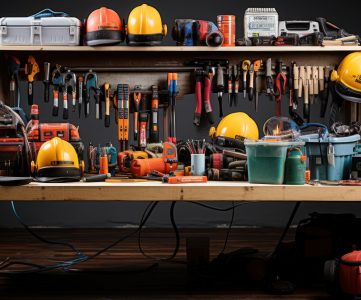Proper stair lighting is key for home safety, preventing accidents at night. It makes your home safe and stylish. The right lighting makes your stairway welcoming.
Stair lighting is vital in home design, blending safety and style. It improves your home’s look and keeps everyone safe. Safety lighting is crucial in stair lighting, important for your home’s design.
Key Takeaways
- Proper stair lighting is essential for safety and style
- Stair illumination helps prevent accidents, specially at night
- Safety lighting is a critical aspect of stair lighting installation
- Stair lighting can enhance the overall look of your home
- Combining safety and style is crucial for stair lighting design
- Stair illumination can create a welcoming ambiance in your stairway
Understanding the Importance of Stair Lighting
Stair lighting is key for home safety, mainly for the elderly and young kids. Safety lighting cuts down on stair accidents. Many accidents happen because of bad lighting, showing we need good night lighting options.
Some main benefits of good stair lighting are:
- Less chance of falls and injuries
- Higher home value with nice lighting
- Less harm to the environment with energy-saving lights
Adding safety lighting and night lighting makes homes safer and more welcoming. It’s clear that stair lighting is a must-have for any home.
Accident Prevention Statistics
Good lighting can stop many stair accidents. With the right lighting, homes become safer for families.
Enhanced Home Value Benefits
Good stair lighting also boosts a home’s value. Stylish, energy-saving lights make homes more attractive to buyers.
Energy Efficiency Considerations
Energy-saving is important for stair lighting. Choosing lights that use less energy helps the planet and saves money on bills.
Types of Stair Lighting Solutions
There are many stair lighting options, each with its own benefits. Step lights focus light on each step, making stairs safer and easier to see. Where you place the lights is also key, affecting both safety and style.
Popular choices include LED strips, recessed lights, and post lights. These can make your stairs look modern or traditional. For instance, LED strips offer a sleek look, while recessed lights add elegance.
When picking a stair lighting solution, consider a few things:
- Energy efficiency: Choose options like LED lights that save energy.
- Style: Pick a lighting solution that matches your home’s look.
- Safety: Make sure the lighting is enough for safe stair use.
By thinking about these points and picking the right lighting, you can make your stairs safe and stylish. Whether you want something modern or traditional, there’s a solution for you.
| Lighting Type | Benefits | Considerations |
|---|---|---|
| LED Strips | Energy-efficient, modern look | Can be expensive, may require professional installation |
| Recessed Lights | Traditional look, easy to install | May not be as energy-efficient as other options |
| Post Lights | Classic look, easy to install | May not provide adequate lighting for safety |
Smart Stair Lighting Technologies
Smart stair lighting has changed how we light our stairs. It uses motion detection to turn on lights as you approach. This makes lighting your stairs easy and safe.
Some key features of smart stair lighting include:
- Motion sensor integration for automatic lighting
- Voice control options for easy control
- Mobile app controls for remote access
These features add convenience and safety to your home. Motion detection ensures your stairs are always lit. This reduces the chance of accidents.
Smart stair lighting also saves energy. It only lights up when needed, cutting down on energy use. You can control your lights with a mobile app, turning them off when not in use.
| Feature | Benefit |
|---|---|
| Motion Sensor Integration | Automatic lighting for convenience and safety |
| Voice Control Options | Easy control and accessibility |
| Mobile App Controls | Remote access and energy efficiency |
Smart stair lighting brings many benefits. It makes your home safer, more convenient, and energy-efficient. With features like motion detection, you can enjoy a better home.
Planning Your Stair Lighting Project
Planning your stair lighting project involves several key steps. Measuring your stairs is the first thing to do. It helps you figure out how many lights you’ll need. You should also think about the installation methods you’ll use, whether you’re doing it yourself or getting a pro.
A good plan for your stair lighting can really improve your home’s safety and look. Here are some tips to keep in mind:
- Pick the right lights for your stairs, matching the style and material.
- Think about the installation methods you’ll use, like wired or wireless.
- Decide how bright you want the lights to be and choose the right ones.
By considering these points and picking the right installation methods, you can make a beautiful and useful stair lighting system. It will make your home safer and more stylish.
Essential Tools and Materials for Installation
Installing stair lighting needs the right tools and materials for success. The way you install and place the lights affects the final look. So, being well-prepared is key. We’ll cover the tools and materials you need for a safe and working stair lighting system.
First, know what tools and materials you need. You’ll need wire strippers, pliers, and screwdrivers for the job. Also, safety gear like gloves, safety glasses, and a ladder is crucial. They protect you from electrical shocks and falls.
Required Tools Checklist
- Wire strippers
- Pliers
- Screwdrivers
- Drill
- Level
Recommended Safety Equipment
- Gloves
- Safety glasses
- Ladder
- Non-slip mat
Correct wiring and connections are key for safe and beautiful lighting. By using the right installation methods and placing lights well, you’ll get a stunning and safe stair lighting system.
Wiring and Connection Materials
| Material | Description |
|---|---|
| Wire | Used for connecting lights and power source |
| Connectors | Used for securing wires to lights and power source |
| Electrical tape | Used for insulating and protecting wires |
With the right tools and materials, you’re ready for a successful stair lighting installation. Always follow the right installation methods and think about where to place the lights. This will ensure a safe and functional system.
Professional Stair Lighting Installation Guide
Installing stair lighting is all about safety. A pro can make sure the safety lighting fits right, keeping the stairs lit and safe. They’ll check the stairs, landings, and any dangers.
A good stair illumination system makes the stairs look better and safer. You can pick lights like LED strips or recessed ones. Then, place them to make the stairs warm and welcoming.
Here’s how to do it right:
* Check the stairs well
* Pick the best lights
* Plan where to put them for the best safety lighting and stair illumination
* Install carefully, following safety rules
By doing these steps, you get a safe and stylish stairway lighting.
Design Ideas and Aesthetic Considerations
Stair lighting offers endless design options. You can choose from modern step lights to elegant chandeliers. The right lighting can make your home look better.
Think about your home’s style and the mood you want. Warm white lights make a cozy feel. Cool white lights are brighter and more energizing.
Match your stair lighting with your home’s natural light. If your home gets lots of daylight, warm tones at night can be relaxing.
Modern Lighting Trends
- Minimalist step lights for a sleek and modern look
- LED strip lights for a futuristic and energy-efficient option
- Chandelier-style fixtures for a touch of elegance and sophistication
Match your stair lighting with your home’s materials and textures. For example, wood accents look good with natural wood tone lights. Choosing the right lighting can make your home look beautiful and functional.
Maintenance and Troubleshooting Tips
To keep your stair lighting system working well, regular maintenance is key. This means cleaning the lights and fixtures, replacing bulbs when they go out, and checking for damage. Motion detection systems are great because they turn on the lights automatically when someone comes near the stairs.
Problems like faulty motion detection sensors, burned-out bulbs, and electrical issues can happen. Start by checking the power source and making sure all connections are tight. If the problem doesn’t go away, it’s time to call a professional electrician.
Here are some more tips for keeping your stair lighting system in good shape:
- Regularly check the lights and fixtures for dust and dirt, and clean them as needed
- Replace bulbs with energy-efficient options to save money and reduce waste
- Consider installing a smart lighting system that can be controlled remotely and adjusted to different settings
Building Code Requirements and Safety Standards
Stair lighting installation must follow building codes and safety standards. This makes sure the lighting works well and is safe for everyone. Safety lighting is key in building design, and stairs are no different.
In the United States, homes and businesses must follow certain rules. The International Residential Code (IRC) and the International Building Code (IBC) set guidelines for stair lighting. These rules cover what kind of lighting, how bright it should be, and where it should go.
Important things to think about include:
- Emergency lighting standards, which keep stairways lit during power outages or emergencies
- Lighting intensity and uniformity, which must meet specific standards to prevent accidents and ensure visibility
- Compliance with local and national building codes, which may vary depending on the location and type of property
By following these rules, property owners can make sure their stair lighting is both useful and safe. This protects users and helps avoid accidents and legal issues.
| Building Code | Requirement |
|---|---|
| International Residential Code (IRC) | Minimum lighting intensity of 1 foot-candle at the stair tread |
| International Building Code (IBC) | Emergency lighting standards for commercial properties |
Cost Analysis and ROI
Understanding the costs and potential return on investment for stair lighting is key. Different installation methods and lighting placement options can greatly affect the cost. A well-designed stair lighting system can boost your home’s value and save energy in the long run.
Material and labor costs are important to consider. The price of lighting fixtures, wiring, and controls varies a lot. The complexity of the installation, like the number of stairs and landings, also impacts labor costs. Here are some key factors:
- Material costs: fixtures, wiring, and controls
- Labor costs: installation time and complexity
- Energy efficiency: long-term savings on energy bills
Experts say a good stair lighting system can recover up to 50% of its cost at resale. This makes it a smart choice for homeowners wanting to improve their stairs’ safety and style. By picking the right installation methods and lighting placement, you can make your stairway both beautiful and functional, increasing your home’s value.
In summary, a detailed cost analysis and understanding of ROI are crucial for your stair lighting project. By looking at all the factors, you can create a stunning and safe stairway that offers long-term benefits.
Conclusion: Illuminating Your Path to Safety and Style
The role of stair lighting is crucial. A good stair illumination system boosts safety and looks. It makes your home safer, more valuable, and energy-smart. Plus, it adds to your stairs’ style and feel.
Choosing the right lighting is key. You might prefer motion sensors, voice control, or something that fits your home’s look. This guide helps you find the perfect lighting for your home. It ensures your home is safe, stylish, and well-lit.






